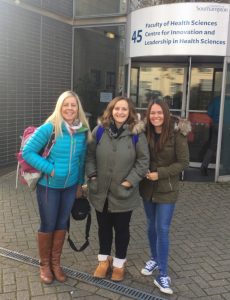Physiotherapy students at the university of Southampton can hook up onto a live research project at the Faculty of Health Sciences.
Three students elected to get involved with the ‘Using Technology for Safer Walking’ project, Amy Broughton, Ange Briggs and Hayley Grainger.

Studying research methods courses over years two and three of their degree, the students learned about methods, developed a proposal for the research, applied for ethical agreement in year two. In year three they undertake the project and write an article for publication about it.
Currently at the point of data collection, the students have developed many skills and implemented them. They reflected on learning about research methods connected to real life project:
Amy said
Having previously had no experience of research this module was very daunting for me as I had no idea what to expect.
Learning the theory and being able to put it into practise has provided an excellent learning environment. The opportunity of seeing a project through from start to finish and learning the ins and outs of what it takes to conduct research has provided me with much insight into the world of research, these skills will help me moving forward as I graduate and head into clinical practice.
The qualitative nature of this project has really highlighted how people interact with technology and their environment in day to day life, at times it seemed to make participants realise a few things about their own behaviours, seeing them reflect and realise was very interesting.
Hayley
Qualitative research allowed me to gain an insight into my study from a participant’s prospective, from a holistic view. Using a semi structured interview allowed participants to take the lead and created interesting results that could not be predicted prior to the study commencing.
Ange
I was fascinated to learn about Ethnographical studies and seeing first hand how people interact with their surroundings and react when under observation. I was also intrigued to witness how the theory behind navigating, (a person must understand the relationship between the map, the space and themselves within that space) played out in practice.
Their research project examined how nine healthy participants, fellow students, negotiated navigating an unknown path using three different types of aid. The first was to have verbal instructions to follow. The second was to use a smartphone with GPS on it, and the third was a map. The participants who were given verbal instructions fared worst of the three groups, as all three of the participants got lost. The smartphones users found their way, but were distracted during the task which could be a safety issue, and the map users found their way once they had managed to orientate themselves.
The knowledge of where you are and how to get around is often taken for granted. Giving verbal instructions is usual, but even in healthy adults proved problematic. This is very important for us to know when considering how people with dementia may struggle to navigate. Even very familiar surroundings may be confusing, and take some time to work out and find a way. Verbal instructions, for the provider seem obvious, but of course for the receiver, are frequently oblivious. This is also something to bear in mind when we are thinking about how best to support a person with dementia – verbal instructions are unlikely to be effective.
Having completed the data collection, the students are ready to complete their analysis. We can update you further when that is complete and look forward to reading more about this fascinating addition to the Using Technologies for Safer Walking project.



